A powerful installation by Edwin Vasquez now at Angels Gate Cultural Center marks the fulfilment of a grant received by the artist. As a part of the Seven Visions X Seven Artists exhibition, Vasquez offer a compelling work created through the MRH Fund for Artists program, which supports artists to expand their creative reach.
The work at Angels Gate is part of the artist’s multidisciplinary series expressing the rich significance of the Joshua Tree, otherwise known as the Yucca brevifolia. Vasquez’s realization of the massive undertaking he calls The Joshua Tree Chronicles grew from an initial written account to one that includes a widerange of visual art including multimedia.
His work combines photography, mixed media, recycled material, digital art, images generated through AI, video, and poetry. His purpose is to reveal the tree itself in an accessible way that also allows viewers to experience it with fresh eyes and become more aware of the variety of problems facing the tree in the Antelope Valley.
Calling the Joshua Tree “an iconic symbol of endurance,” Vasquez informs his work for this project with the tree’s unique profile, revealing its strength despite the harsh desert environment in which it grows. Having successfully survived in that environment now its resilience is challenged due to climate change, loss of habitat due to increased human encroachment, and wildfires, all of which threaten its survival and reflect the larger ecological crisis facing us today.
Connecting the Joshua Tree with human experience is one of Vasquez signature themes in this project, revealing both its graceful beauty and extreme vulnerability in his diverse works. While some images emphasize the interconnectedness between the tree and humans, others present potential futures and new perspectives, or unfold a motion-centered narrative that lead viewers through a journey that is both empathetic and a contemplative, designed to raise awareness for necessary conservation. Vasquez has grown more aware of this need himself after a Plant a Tree event organized by Transition Habitat Conservancy at Portal Ridge Wildlife Preserve, at which he and his family planted some 40 baby Joshua Trees.
His work represents what is truly a passion project for Vasquez. He relates that “Last year, the laws protecting the Joshua Tree made headlines, and one of our local politicians claimed that we have a housing problem. He voted against the protection of the tree in our community, the Antelope Valley. Unfortunately, some of the best real estate is filled with trees, and in order to build these natural landscapes get destroyed, along with the ecosystem that serves as the tree’s home…Determined to make a difference, I decided to initiate [what I describe as] the #JoshuaTreeChronicles on my own.”
Vasquez explains that he’s documented the Joshua Tree through photography “for quite some time,” but his current project offered “a new opportunity to craft a comprehensive body of work” encompassing many different artistic practices. “In a sense, this marks a new direction in my artistic practice,” he says.
The installation at Angels Gate Cultural Center is one riveting aspect of it. Inspired by a visit to a private property in Lancaster, Calif., which he documented with video and photographic art, the instalaltion creates an entire landscape for the tree itself and the fraught environment it now faces.
Vasquez uses a rich and vibrant palette, which he describes as “inspired by Guatemalan textiles which are colorful and profound. I also find those colors in the desert while hiking, while observing the sunrise or the sunset. The colors represent the distinctive light changes in our area from the softest pinks to the fire reds.”
The installation includes three main components: “Joshua Tree 1,” mixed media on canvas, “Joshua Tree 2,” also mixed media on canvas, and “Joshua Tree” (above), a mixed media installation that includes canvas, found objects, and sand.
At the base of “Joshua Tree,” the largest image of the three in the exhibition, there is a carved totem, an orange safety cone, abandoned water containers, and a rainbow painted tire – the detritus left by man in the desert,.
A sculptural work to the right of this central installation image features abandoned digital components, in a robotic interpretation of what could be a future Joshua Tree.
The sides of the sculpture’s base, featuring painted desert images, can be illuminated in a magical incandescence by the use of a portable black light. A video of Joshua Trees plays on a small wall monitor behind it.
On the opposite side of “Joshua Tree”, the other mixed media on canvas works are hung bracketing another sculptural work, this a series of arrows buried point down in a foam block painted with graffiti and also holding a can of fluorescent spray paint. At the bottom of the block there is a radiant blue and gold image of a Joshua Tree rising from the glow of city lights. The colors and its illumination resemble an icon image of a Catholic saint. At the base of the foam block, another traffic cone, a foam recreation of a Starbucks cup, crumpled papers, and another abandoned water container lie.
Each of the canvas and mixed media wall art pieces contains distinct elements, with “Joshua Tree” featuring a found-object yellow lizard, with a grid-like pattern of orange, blue, gold, and greens as the tree’s limbs, and mandala like shapes representing its leaves. On the ground around the tree are glowing rocks and flowers. “Joshua Tree 1 and 2” each visualize the branches and trunk of the tree as a solid green, with a grid-like pattern forming the sky and a ground-scape in greens, yellows and reds speckled with white and orange flowers in the first image. In the second, representational leaves grow from the tree’s arms, a golden-pebbled road leads out to the dark desert hills in the background. Spikey greenery and white and orange flowers cluster on the sand. In the near distance, desert houses float on the skyline and a multicolored moon hangs above them. The details of each unique work are both reverent and edged with the abstract and surreal, not unlike the mysterious, alien, and beautiful nature of the trees themselves and the chaos of human response to their preservation.
The masterful and passionately elegiac installation also includes a QR code for a moving short video, “Expect the Unexpected,” which can be viewed here, on the artist’s YouTube channel, edwinvasquez100.
Vasquez says that he wants viewers to see his project “in a positive light. Perhaps the best analogy I could use is that much like immigrants who may lack a voice, these plants in the Antelope Valley also face a similar predicament. Someone must at the very least bring attention to the issues they are confronting within the community. As an artist, I believe it is my responsibility to create art that highlights the significance of this unique tree in our community.”
Art in Residence nominated Vasquez for the installation’s commission, with Georgia Freedman-Harvey, the founder and director of MRH Fund for Artists, selecting the project as a part of the impressive collection of works in 7 Visions X 7 Artists. It’s a radiant start to exhibiting Vasquez’ Joshua Tree works. At UCLA Chicano Studies, the artist recently installed 20 other art pieces which are a part of the same mammoth project.
Here’s to Vasquez and the Joshua Tree continuing to grow and blossom. The Angels Gate exhibition closes with an artist talk and reception on February 24th from 2 to 4 p.m.
- Genie Davis; photos: Genie Davis, and as provided by the artist



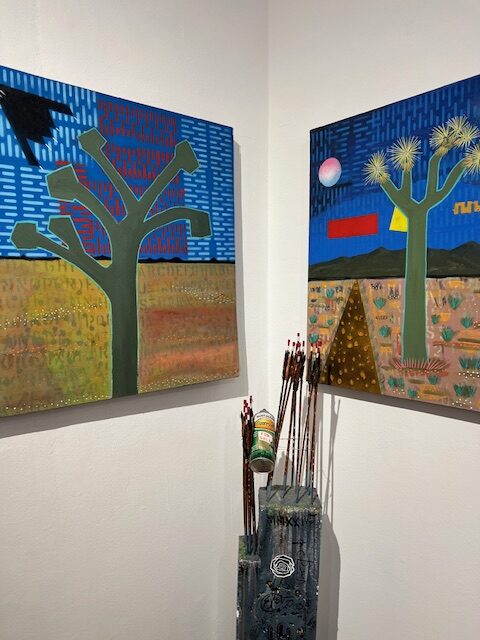
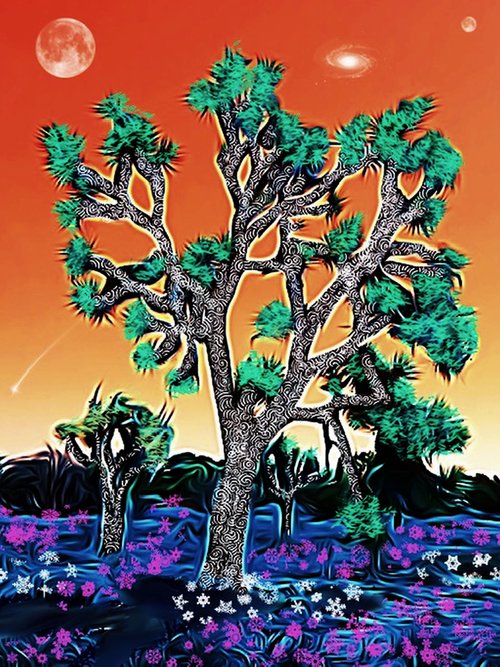






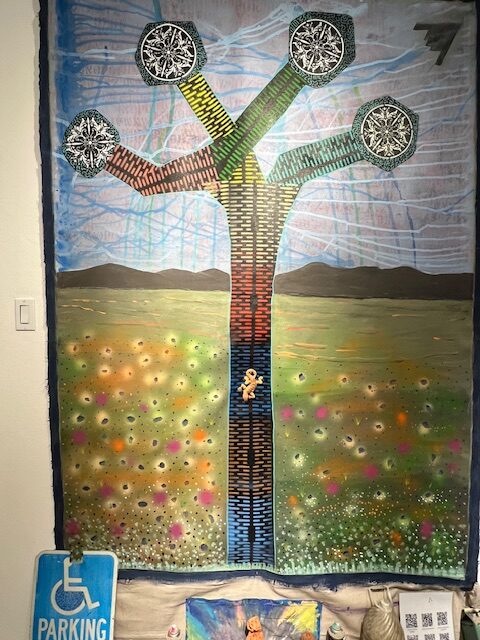
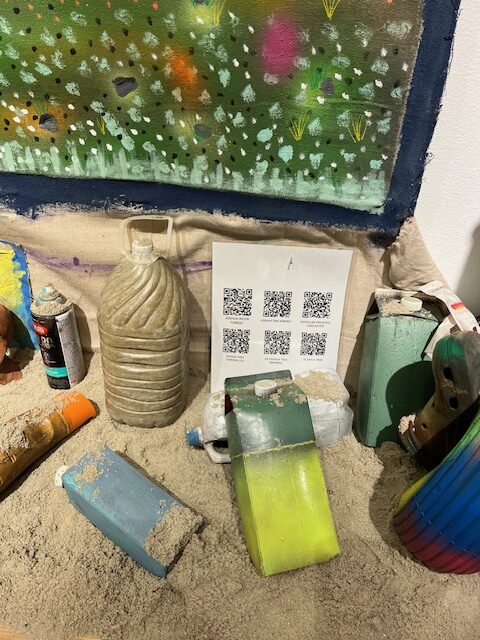
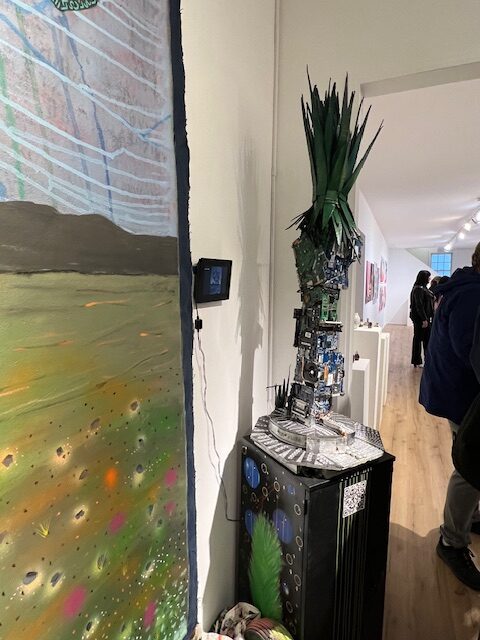



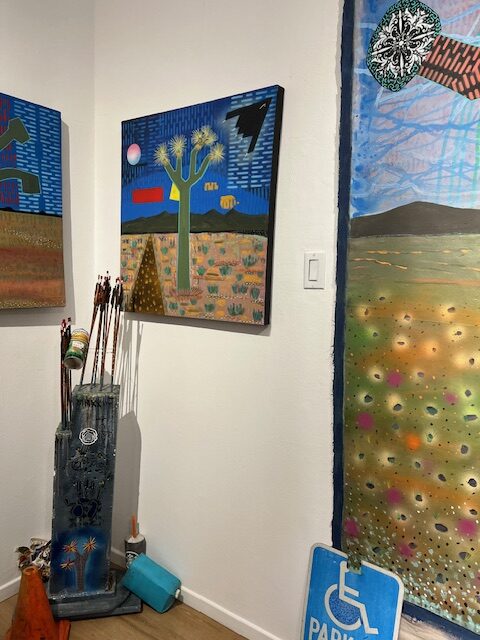






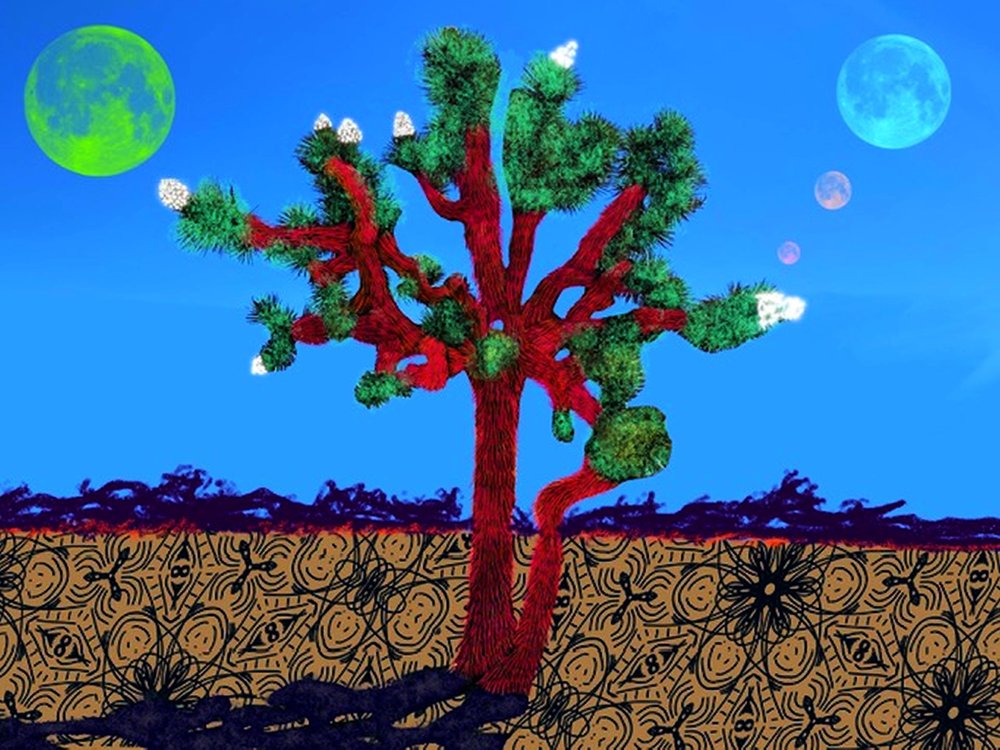
Informative, educational information provided by a writer and artist that loves the desert and these trees. Beautifully written and striking art illustrates the tenacity and the fragility of a plant that has survived a very harsh environment.
Kudos Edwin!!
And to Genie for your insightful writing!
Beautiful powerful exhibit at Angel’s Gate Cultural Center in San Pedro. Worth the visit.